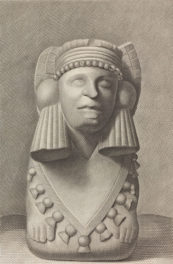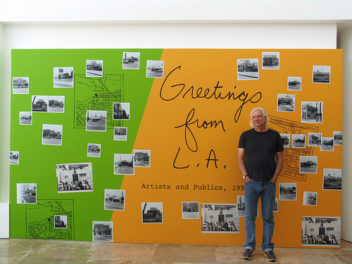Try it at home: this recipe packet contains nine delicious Korean recipes, including prawns, stuffed cucumber, punch, barbecued beef.

Korean dishes at the Getty Restaurant by Mayet Cristobal
Cultural exchange can lead to delicious discoveries. Exchange with Korean scholars, for example, led to new insights revealed in the exhibition Looking East: Rubens’s Encounter with Asia. As the exhibition was coming together, another exchange—of the culinary variety—was cooking behind the scenes.
Mayet Cristobal, chef of the Restaurant at the Getty Center, wanted to create the perfect menu in honor of Mesmerizing Beauty, a fashion show at the Getty Center celebrating traditional Korean dress known as hanbok, and produced by staff and volunteers from the Korean Cultural Center.
Volunteers didn’t just create the costumes, sew, iron, and prep them, do the makeup, and perform on stage—they were ready to help with Mayet’s menu, too. Yun Choi of the Korean Cultural Center and her mother brought 30 traditional Korean home-cooked dishes to the table for Mayet to sample.
Originally, Korean community members expected a very traditional approach for the menu with dishes like oiseon (stuffed cucumber), hwayangjeok (seasonal beef dish), yaksik (rice ball), and bin dae tteok (myung bean pancake). “For me living in Los Angeles, when I think Korean food, I’m thinking K-Town—grilled meats, tofu, kimchi, banchon,” Mayet told me. “I tasted all the foods Yun Choi and her mother brought and was excited to think how I could put my spin on this and make it more of an L.A. style. But the next week, they came to try my kimchi and reacted like, ‘Oh, it’s good…’ I knew they wanted to say something else.” What happened then? They showed Mayet how to properly make kimchi the “quick United States way”—which takes only a week.
As Mayet was learning to prepare authentic Korean cuisine, she also had fusion in mind. “I was looking at new and upcoming chefs like David Chang from Momofuku in New York. He’s doing Asian takes on familiar food, like tacos with Korean beef and sauce on a steamed bun. It’s new with traditional flavors mixed together.”

Yaksik by Yun Choi
Yun Choi, by contrast, wanted to stress the essence of Korean cooking, the philosophical foundation of the food. “There are many essential elements,” is how she puts it, “but one of the most prominent is the idea of health. We use fresh seasonal vegetables in our dishes a lot, so we provide a lot of nutritional content. Another integral part is the idea of helping to prolong life. Thus the other name for Korean food: healing food.”
So, taking inspiration from the Korean way of using fresh, seasonal, available ingredients, Mayet adjusted the recipes for the menu to include vegetables from local vendors. Instead of daikon, for example, she used Easter egg radish, a tiny pink radish grown locally. “We also use rainbow carrots that come in purple, red, pale yellow, and, of course, orange,” she said. “Japanese cucumber is smaller and sweeter and used for the pickled dish. It makes our dishes a bit different, but the flavors are still traditionally Korean.

Japchae by Yunchoi
To taste the results of this culinary exchange, a delicious vegetarian japchae (noodles with vegetables), barely unchanged from Yun Choi’s mother’s family recipe, is now available in the Cafe at the Getty Center. A fine-dining menu with a more traditional mix of braised beef, rice, and banchon is being served in the Restaurant. For home chefs intrigued by the international flavors of Korean cuisine, Yun Choi also helped to prepare a special downloadable PDF packet of nine of her favorite Korean recipes, which we hope you enjoy.
So here’s to a cross-cultural culinary exchange, and to Rubens’s cross-continental drawing that brought the East to the West.




Comments on this post are now closed.